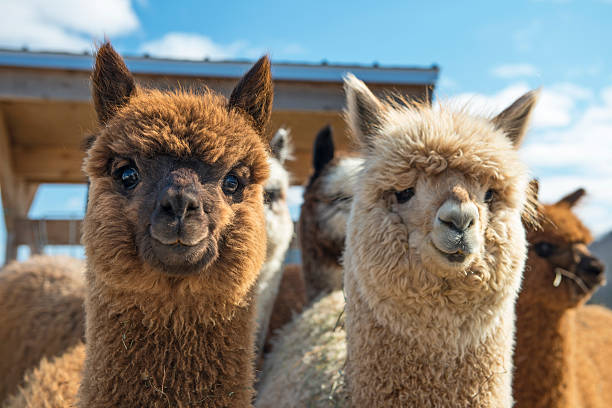Therapeutic Alpacas: Nature's Fluffy Stress-Busters
In a world where stress and anxiety are on the rise, an unexpected hero has emerged from the pastoral landscapes of South America. Alpacas, with their gentle demeanor and endearing appearance, are making waves in the field of animal-assisted therapy. This article delves into the fascinating world of therapeutic alpacas, exploring their unique qualities and the growing trend of using these wooly wonders to promote mental well-being.

Their soft, fluffy coats invite tactile interaction, providing a soothing sensory experience for individuals dealing with stress, anxiety, or sensory processing disorders. The act of petting or hugging an alpaca can trigger the release of oxytocin, the “feel-good” hormone associated with bonding and relaxation. This physiological response can lead to reduced stress levels, lower blood pressure, and an overall sense of calm.
From Pasture to Therapy: The Rise of Alpaca Interventions
The use of alpacas in therapeutic settings has gained traction in recent years, with programs popping up across the United States, Europe, and Australia. These initiatives range from alpaca farm visits for individuals and groups to more structured therapy sessions involving trained alpacas and licensed mental health professionals.
One notable program, “Alpaca Therapy USA,” has seen a 300% increase in participation over the past five years. This surge in interest has prompted research into the efficacy of alpaca-assisted interventions, with preliminary studies showing promising results in reducing symptoms of depression, anxiety, and post-traumatic stress disorder (PTSD).
Alpaca Aromatherapy: An Unexpected Olfactory Experience
While the visual and tactile aspects of alpaca therapy are well-documented, recent research has uncovered an unexpected benefit: their unique scent. Contrary to popular belief, alpacas have a mild, pleasant odor that some describe as reminiscent of freshly cut grass or sun-warmed hay.
A study conducted at the University of Melbourne found that exposure to the natural scent of alpacas had a calming effect on participants, reducing cortisol levels and promoting a sense of well-being. This discovery has led to the development of “alpaca aromatherapy” programs, where individuals can experience the soothing scent of alpacas in controlled environments.
Beyond Mental Health: Alpacas in Physical Rehabilitation
The therapeutic potential of alpacas extends beyond mental health applications. Physical therapists and occupational therapists are beginning to incorporate alpaca-assisted activities into their treatment plans for patients recovering from injuries or living with chronic conditions.
The gentle, rhythmic movement required to walk alongside an alpaca can help improve balance, coordination, and muscle strength. For individuals with mobility issues, interacting with alpacas provides motivation to engage in physical activities and can contribute to improved motor skills and overall physical function.
The Economic Impact: Alpaca Therapy as a Growing Industry
As the popularity of alpaca-assisted therapy grows, so does its economic impact. Alpaca farms that once focused solely on fiber production are now diversifying their offerings to include therapeutic programs. This shift has created new revenue streams for farmers and job opportunities for trained animal handlers and therapy professionals.
The estimated value of the alpaca therapy industry in the United States alone is projected to reach $50 million by 2025, with an annual growth rate of 15%. This expansion has also led to the development of specialized training programs for alpacas and their handlers, ensuring high standards of care and safety in therapeutic settings.
Challenges and Considerations in Alpaca-Assisted Therapy
While the benefits of alpaca therapy are becoming increasingly evident, the field is not without its challenges. Proper training and certification for both animals and handlers are crucial to ensure the safety and effectiveness of therapy sessions. Additionally, considerations must be made for the welfare of the alpacas themselves, including appropriate housing, nutrition, and rest periods between therapy sessions.
Allergies and zoonotic disease transmission are also concerns that must be addressed through rigorous health screening and sanitation protocols. As the field continues to evolve, ongoing research and the development of best practices will be essential to maximize the therapeutic potential of alpacas while prioritizing the well-being of both animals and participants.
The Future of Fluffy Therapy: Expanding Horizons
As awareness of the benefits of alpaca-assisted therapy grows, new applications are continually being explored. From programs targeting at-risk youth to initiatives supporting individuals with autism spectrum disorders, the versatility of alpaca therapy is opening doors to innovative treatment approaches.
The integration of technology is also shaping the future of alpaca therapy. Virtual reality experiences featuring alpacas are being developed for individuals who may not have access to in-person interactions, potentially expanding the reach of these therapeutic interventions to a global audience.
In conclusion, therapeutic alpacas represent a unique and promising frontier in animal-assisted therapy. As research continues to validate their effectiveness and new applications emerge, these gentle, woolly creatures are poised to play an increasingly significant role in promoting mental and physical well-being. The rise of alpaca therapy not only offers hope to those seeking alternative therapeutic approaches but also highlights the profound impact that human-animal connections can have on our health and happiness.





